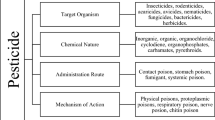Abstract
Mineralization of diuron has not been previously demonstrated despite the availability of some bacteria to degrade diuron into 3,4-dichloroaniline (3,4-DCA) and others that can mineralize 3,4-DCA. A bacterial co-culture of Arthrobacter sp. N4 and Delftia acidovorans W34, which respectively degraded diuron (20 mg l−1) to 3,4-DCA and mineralized 3,4-DCA, were able to mineralize diuron. Total diuron mineralization (20 mg l−1) was achieved with free cells in co-culture. When the bacteria were immobilized (either one bacteria or both), the degradation rate was higher. Best results were obtained with free Arthrobacter sp. N4 cells co-cultivated with immobilized cells of D. acidovorans W34 (mineralization of diuron in 96 h, i.e., 0.21 mg l−1 h−1 vs. 0.06 mg l−1 h−1 with free cells in co-culture).




Similar content being viewed by others
References
Bettmann H, Rehm HJ (1984) Degradation of phenol by polymer entrapped microorganisms. Appl Microbiol Biotechnol 20:285–290
Cassidy MB, Lee H, Trevors JT (1996) Environmental applications of immobilized microbial cells: a review. J Ind Microbiol 16:79–101
Cassidy MB, Shaw KW, Lee H, Trevors JT (1997) Enhanced mineralization of pentachlorophenol by к-carrageenan-encapsulated Pseudomonas sp. UG30. Appl Microbiol Biotechnol 47:108–113
Dejonghe W, Goris J, Dierickxx A, De Dobbeleer V, Crul K, De Vos P, Verstaete W, Top EM (2002) Diversity of 3-chloroaniline and 3,4-dichloroaniline degrading bacteria isolated from three different soils and involvement of their plasmids in chloroaniline degradation. FEMS Microbiol Ecol 42:315–325
Dejonghe W, Berteloot E, Goris J, Boon N, Crul K, Maertens S, Höfte M, De Vos P, Verstraete W, Top EM (2003) Synergistic degradation of linuron by a bacterial consortium and isolation of a single linuron-degrading Variovorax strain. Appl Environ Microbiol 69(3):1532–1541
Ellis PA, Camper ND (1982) Degradation of diuron by aquatic microorganisms. J Environ Sci Health 17(3):277–289
Jezequel K, Perrin J, Lebeau T (2005) Bioaugmentation with a Bacillus sp. to reduce phytoavailable Cd of an agricultural soil: comparison of free and immobilized microbial inocula. Chemosphere 59:1323–1331
Lebeau T, Jouenne T, Junter GA (1997) Simultaneous fermentation of glucose and xylose by pure and mixed cultures of Saccharomyces cerevisiae and Candida shehatae immobilized in a two-chambered bioreactor. Enz Microbiol Technol 21:265–272
O’Reilly AM, Scott JA (1995) Defined co-immobilization of mixed microorganism cultures. Enz Microbiol Technol 17:636–646
Santos VA, Bruijnse M, Tramper J, Wijffels RH (1996) The magic bead concept: an integrated approach to nitrogen removal with co-immobilized microorganisms. Appl Microbiol Biotechnol 45(4):447–453
Tixier C, Bogaerts P, Sancelme M, Bonnemoy F, Twagilimana L, Cuer A, Bohatier J, Veschambre H (2000) Fungal biodegradation of a phenylurea herbicide, diuron : structure and toxicity of metabolites. Pest Manag Sci 56:455–462
Tixier C, Sancelme M, Bonnemoy F, Cuer A, Veschambre H (2001) Degradation products of a phenylurea herbicide, diuron : synthesis, ecotoxicity, and transformation. Environ Toxicol Chem 20:1381–1389
Tixier C, Sancelme M, Aït-Aïssa S, Widehem P, Bonnemoy F, Cuer A, Truffaut N, Veschambre H (2002) Biotransformation of phenylurea herbicides by a soil bacterial strain, Arthrobacter sp. N2 : structure, ecotoxicity and fate of diuron metabolite with soil fungi. Chemosphere 46:519–526
Tomlin C (1997) The pesticide manual, 11th edn, British Crop Protection Council, Farnham, Surrey, UK, pp 443–445, ISBN 1-901396-11-8
Travkin V, Solyanikova IP, Rietjens IMCM, Vervoort J, van Berkel WJH, Golovleva LA (2003) Degradation of 3,4-dichloro- and 3,4-difluoroaniline by Pseudomonas fluorescens 26-K. J Environ Sci Health 38(2):121–132
Widehem P, Aït-Aïssa S, Tixier C, Sancelme M, Veschambre H, Truffaut N (2002) Isolation, characterization and diuron transformation capacities of a bacterial strain Arthrobacter sp. N2. Chemosphere 46:527–534
You IS, Bartha R (1982) Metabolism of 3,4-dichloroaniline by Pseudomonas putida. J Agric Food Chem 30:274–277
Acknowledgement
We are very grateful to Jerome Kuntz, assistant engineer (Plate-Forme Technologique AGROSYSTEMES), for his technical assistance and to Martine Sancelme and Winnie Dejonghe for providing us strains of Arthrobacter sp. N4 and D. acidovorans W34, respectively.
Author information
Authors and Affiliations
Corresponding author
Rights and permissions
About this article
Cite this article
Bazot, S., Bois, P., Joyeux, C. et al. Mineralization of diuron [3-(3,4-dichlorophenyl)-1, 1-dimethylurea] by co-immobilized Arthrobacter sp. and Delftia acidovorans . Biotechnol Lett 29, 749–754 (2007). https://doi.org/10.1007/s10529-007-9316-7
Received:
Revised:
Accepted:
Published:
Issue Date:
DOI: https://doi.org/10.1007/s10529-007-9316-7




